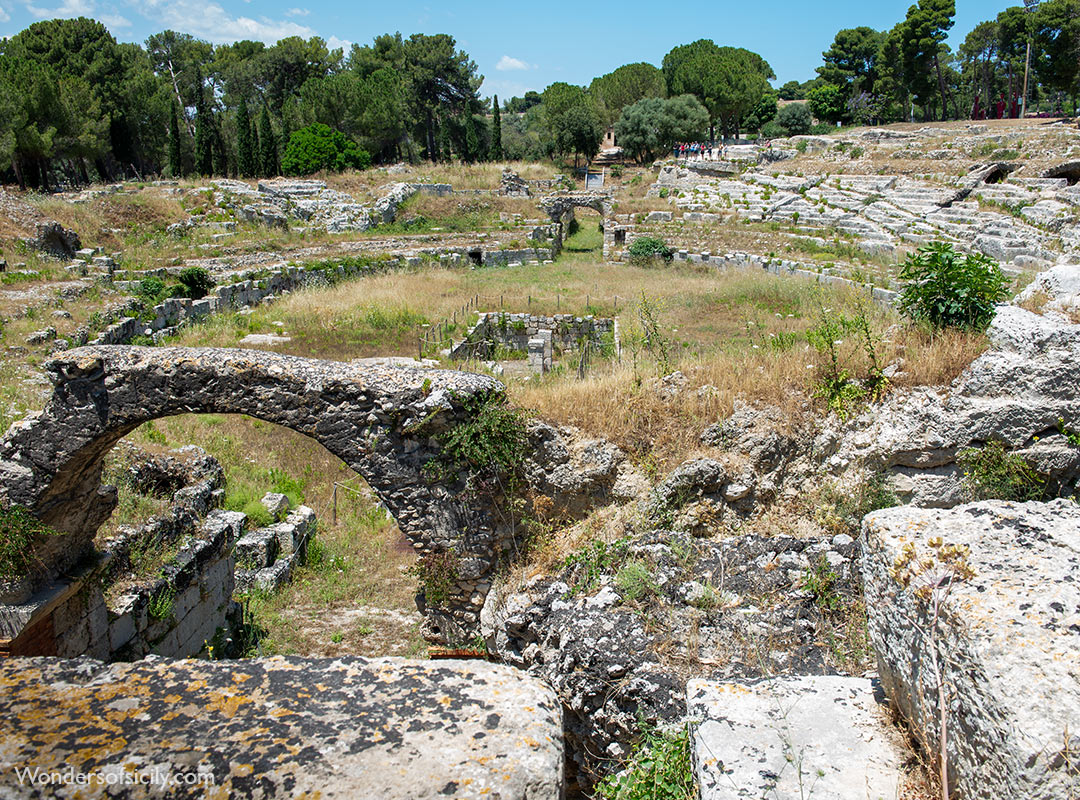The Roman Amphitheatre in Siracusa / Syracuse
The Romans conquered Sicily definitely in 212 BC and ruled over the island until the Vandals led by their chief Genseric conquered it in AD 440.
The Roman amphitheatre in Siracusa (140m by 119m). It was used for gladiator fights. The rectangular depression was probably for the machinery used in the spectacles.
Gladiatorial combat likely began as funeral rites during the Punic Wars (3rd century BC) and soon became central to Roman politics and entertainment. The games reached their height between the 1st century BC and 2nd century AD, featuring lavish spectacles. However, Christian disapproval and changing societal values led to the games’ decline in the 5th century.

The Roman Amphitheatre (detail).
The origins of gladiators and their games are debated. Nicolaus of Damascus (1st century BC) believed they were Etruscan, while Livy attributed their first appearance to the Campanians in 310 BC after a victory over the Samnites. Isidore of Seville (7th century AD) linked the word “lanista” (gladiator manager) and “Charon” (an arena official) to Etruscan roots.
Some modern scholars support a Campanian origin based on pictorial evidence, such as 4th-century BC Paestum frescoes showing fighters in funeral rites. Livy credits Rome’s first gladiator games in 264 BC to Decimus Junius Brutus, honoring his father. The games evolved through Rome’s conflicts with the Samnites, with the Samnite gladiator type becoming the most popular.
Sicilian Sites on UNESCO's World Heritage List
- Agrigento: Archaeological Area of Agrigento (UNESCO)
- Aeolian Islands: Isole Eolie. The group consists of seven islands (Lipari, Vulcano, Salina, Stromboli, Filicudi, Alicudi and Panarea) and five small islets (Basiluzzo, Dattilo, Lisca Nera, Bottaro and Lisca Bianca) in the vicinity of Panarea. (UNESCO)
- Caltagirone (UNESCO)
- Catania (UNESCO)
- Cefalù Cathedral
- Militello Val di Catania (UNESCO)
- Modica (UNESCO)
- Monreale Cathedral
- Mount Etna (UNESCO)
- Noto (UNESCO)
- Palermo: Palazzo dei Normanni (The Norman Palace)
- Palermo: Cappella Palatina (The Palatine Chapel in the Norman Palace)
- Palermo: Church of San Giovanni degli Eremiti
- Palermo: Church of Santa Maria dell'Ammiraglio (also known as the Martorana)
- Palermo: Church of San Cataldo
- Palermo: Cathedral of Palermo
- Palermo: The Zisa Palace (La Zisa)
- Palermo: The Cuba Palace (La Cuba)
- Palazzolo Acreide (UNESCO)
- Ragusa (UNESCO)
- Scicli (UNESCO)
- Syracuse and the Rocky Necropolis of Pantalica (UNESCO)
Gladiatorial games were extravagant tools for political self-promotion in Rome, offering free entertainment while bolstering the influence of their sponsors. Ambitious citizens might delay their munera (gladiator shows) until election season to win votes with lavish spectacles. Even those in power, like Sulla, famously broke sumptuary laws to host opulent games for his wife’s funeral.
Julius Caesar, during his aedileship in 65 BC, staged massive games with 320 gladiators in silver armor, despite immense personal debt. His lavish shows blurred the line between funerary rites and public entertainment, enhancing his popularity. Later, Augustus formalized the games as civic duties, imposing spending limits and restricting private munera. However, even emperors like Trajan, who used 10,000 gladiators and 11,000 animals to celebrate victories, saw costs spiral. Legislation to control spending, including by Marcus Aurelius, failed to curb the growing excesses of gladiatorial games.
The 3rd-century crisis strained the Roman Empire’s finances, making the obligatory gladiator games burdensome for magistrates, though emperors continued subsidizing them due to public demand. Christian writer Tertullian condemned the games, calling them spiritually harmful and a form of pagan sacrifice.
In 365, Emperor Valentinian I sought to limit expenses on gladiatorial games and prevent Christians from being sentenced to the arena. Theodosius I’s adoption of Nicene Christianity in 393 banned pagan festivals, and his successor, Honorius, officially ended the gladiator games in 399 and 404. Valentinian III reinforced the ban in 438. Interest in the games had already declined, though venationes (beast hunts) persisted. In the Byzantine Empire, theatrical shows and chariot races remained popular, with imperial support.
The distance between Siracusa and some other cities in Sicily
Siracusa-Agrigento 217 km
Siracusa-Catania 66 km
Siracusa-Cefalù 249 km
Siracusa-Modica 72 km
Siracusa-Noto 38 km
Siracusa-Palermo 277 km
Siracusa-Ragusa 90 km
Siracusa-Taormina 118 km
Siracusa-Trapani 375 km


